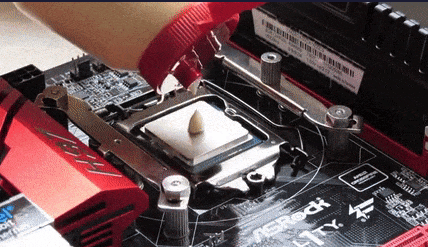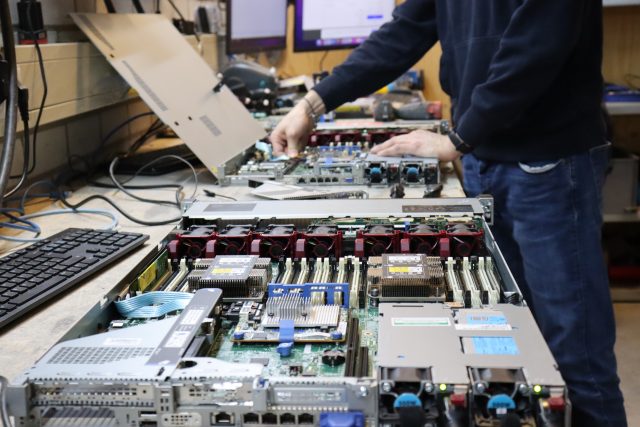At iuppiter, we practice a circular approach to hardware, as opposed to the prevalent, linear way. Thanks to this approach, we reduce the environmental impact of servers by up to 25%, allowing you to improve your IT performance at a lower environmental cost and a fraction of the original price
A server goes through three main phases throughout its life cycle: production, when it is manufactured and assembled; use, when it is running; and disposal, when it gets thrown away. In a linear supply chain, the three phases happen one after the other – when a user needs a new item, the process starts all over again.
By preventing servers from ending up in a disposal facility or, worse, an e-waste dump, we close the loop. This means that instead of throwing items away after a short while and, often, being used by just one person or just for one purpose, we bring them back to life and put them on the market again.
Difference between a linear and circular approach. Source: Het Groene Brein
Server circularity is quite a disruptive practice in an IT market that focuses on constantly supplying users with newer and newer generations. To do so, manufacturers often claim a product’s life cycle is shorter than it actually is (in fancy words, that’s called “planned obsolescence”) and create a lot of mistrust around refurbished IT.
Subsequently, the avarage lifespan - according to many manufacturers - of a server is 3-4 years. When we saw that statistic, we chuckled a little, knowing that a server’s lifetime can easily be doubled without compromising IT performance.
Environmental savings
Extending a server’s lifespan reduces its environmental impact by up to 25%. The total environmental impact of a server across its whole life-cycle – including production, use, and disposal – is between 2.614 and 6.607 kg* of CO2eq**. This means that by buying refurbished, you cut the negative impacts of server hardware by up to 653.5 kg to 1.651.75 of CO2eq.
That’s a carbon saving equal to a person (not) flying from Amsterdam to New York and back!
Bear in mind that these values refer only to greenhouse gas emissions, while the percentage covers the larger environmental impact, including, for example, deforestation or pollution.
The bulk of the environmental savings comes from preventing new production, as the production phase accounts for 20% of a server’s total impact. The remaining 5% is saved by reducing disposal rates, but that’s for next week.
It’s important to stress that the use phase remains the most impactful, accounting for up to 75% of a server’s environmental impact. Such a high value comes mainly from the need for servers to stay operational almost all the time, inciting high energy consumption***.
Yet, the shorter the server’s lifetime, the more impactful its production stage becomes. So what exactly are we preventing with this reduction of environmental impact?
What’s in a server?
There’s a lot that goes into a single server. Some materials are well-known, such as silica, copper, aluminium, steel, and gold. Others sound exotic and are rarely heard of: indium, neodymium, or cobalt.
Each of these minerals must be mined, processed, and smelted before reaching the server factory. Although their impact differs per country, generally, these processes are energy-intensive, environmentally detrimental, and often happen in dubious labour conditions. The material-gathering itself accounts for almost 15% of the total environmental impact of a server, with assembly adding the remaining 5%.
Every step, from mining to assembly, is, of course, fuelled by fossil fuels and so causing greenhouse gas emissions. Researchers estimate approximately 500 kg of CO2eq getting released into the atmosphere for the creation of a single server. All the processes also use a lot of fresh water, which is running scarce in multiple areas of the world.
Yet, that’s just the beginning of production’s environmental impact. To mine, one needs to dig into land and destroy whatever is on it – trees, animals’ habitats, or soil. The landscape gets profoundly transformed, often irreversibly.
Land destruction inflicted by a cobalt mine in the Democratic Republic of Congo. Source for both images: The Guardian
Pollution is another serious problem. Mining, processing, and smelting are dirty processes, releasing dust and aerosols into the air and toxic streams into water and soil. The pollution is dangerous for mining workers who often develop respiratory diseases as well as for the natural environment. It can even travel and negatively affect faraway areas.
A toxic spill from a copper mine in Fujian, China, left fishing villages polluted months afterwards. Source: China Dialogue Ocean
Finally, the production phase comes at a human cost. Mining is often the job of informal workers, not protected by any labour laws and so working in dangerous conditions. They wear no protective equipment so they develop deadly diseases, get buried alive under collapsing mines that weren’t properly reinforced, or don’t get paid a living wage for their hard work. Children are often employed in informal mines. Tech giants Apple and Google were sued in 2017 for being complicit in endangering workers’ lives, which shows just how predominant these situations are.
At iuppiter, we, unfortunately, can’t influence the supply chains of already produced items, but we can lower the demand for producing brand-new. This, in turn, can - and we hope that it will - reduce demand for mining and lead to creating more transparent supply chains.
Boost your corporate responsibility
In short, refurbished servers are a cheaper, more sustainable, and more ethical alternative to brand-new products, with comparable quality. It’s not only a matter of greenhouse gas emissions but also land degradation, workers’ safety, and freshwater use, allowing you to improve your corporate responsibility alongside refreshing your IT infrastructure.
The scarcity of critical minerals is another key aspect that our products – and your purchases - help ease. Stay tuned for next week to learn more, and don’t forget to drop us a message with ideas, thoughts, and suggestions. We’re always happy to hear from you at [email protected].
* This estimate varies a lot for various reasons. Firstly, environmental impact depends on what materials were used, which country they came from, etc. At the same time, it is hard to access accurate data from producers because it is often considered a trade secret.
** CO2eq means “carbon dioxide equivalents”. Although most known, carbon dioxide is never the only greenhouse gas that gets emitted. Sulphur oxides, nitrogen oxides, methane, or the seemingly innocent water vapour, among others, are also contributing to the warming up of our planet. The total warming potential of all greenhouse gases is presented as CO2eq.
*** We hope that all data centres will soon be powered with renewable energy!









